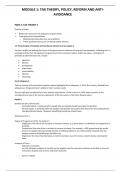Summary
Summary Advanced Taxation Australia (CPA) Notes - 9th Edition S2-2023
- Module
- Institution
THIS STUDY MATERIALS IS THE SUMMARY OF SUBSTANTIAL KNOWLEDGE FROM: - CPA PROGRAM AUSTRALIA TAXATION – ADVANCED NINTH EDITION - KNOWLEDGE EQUITY
[Show more]



